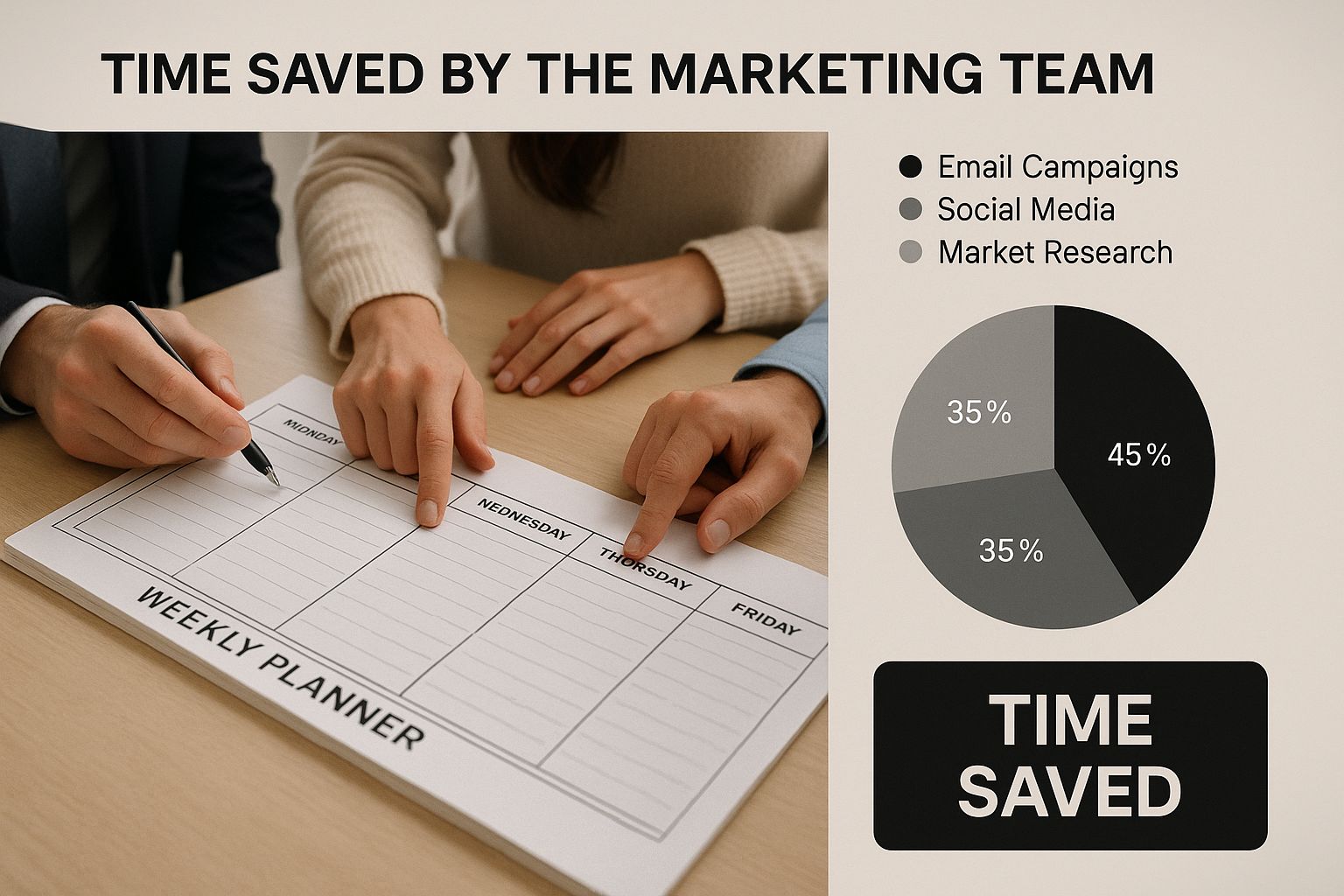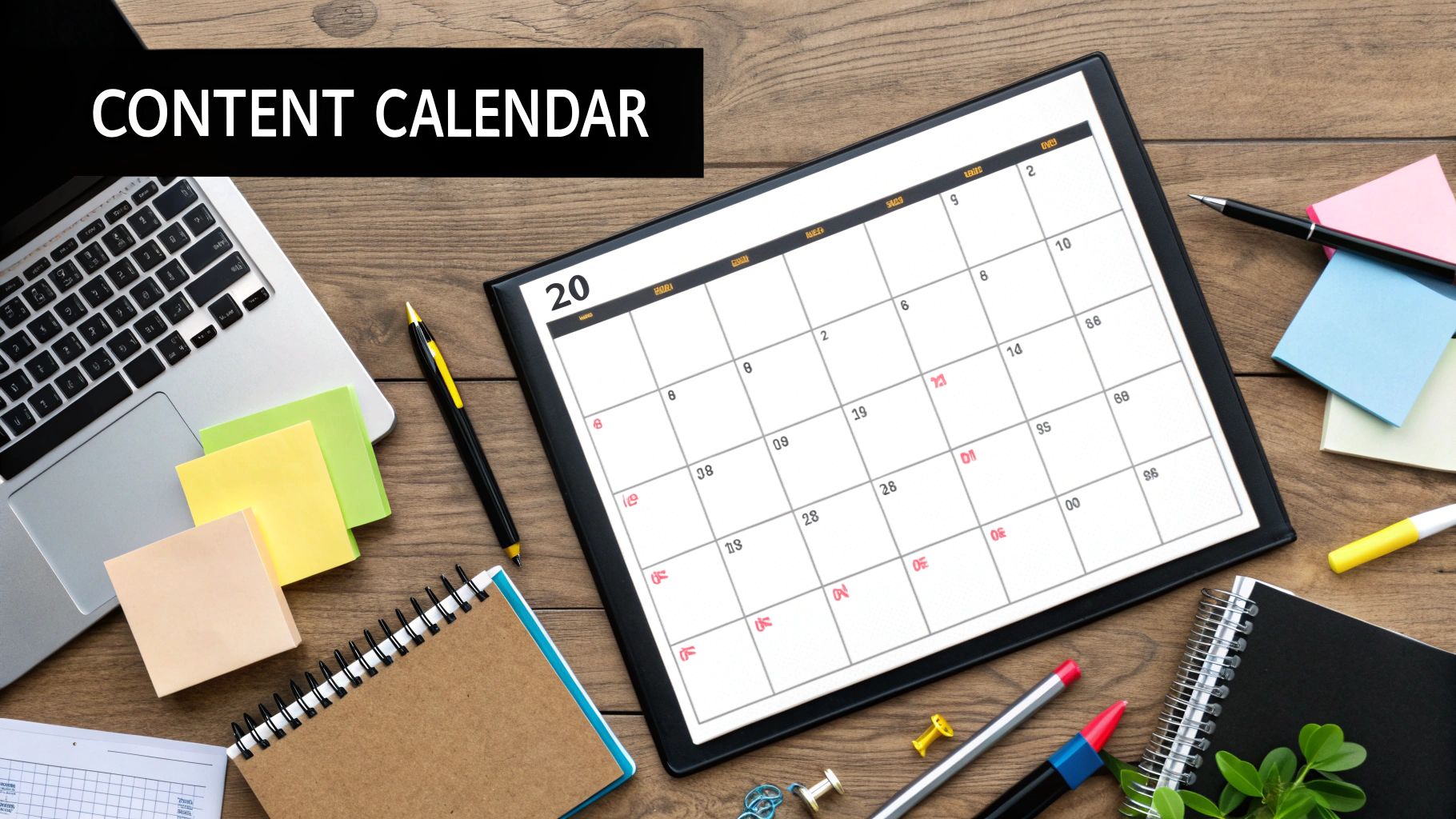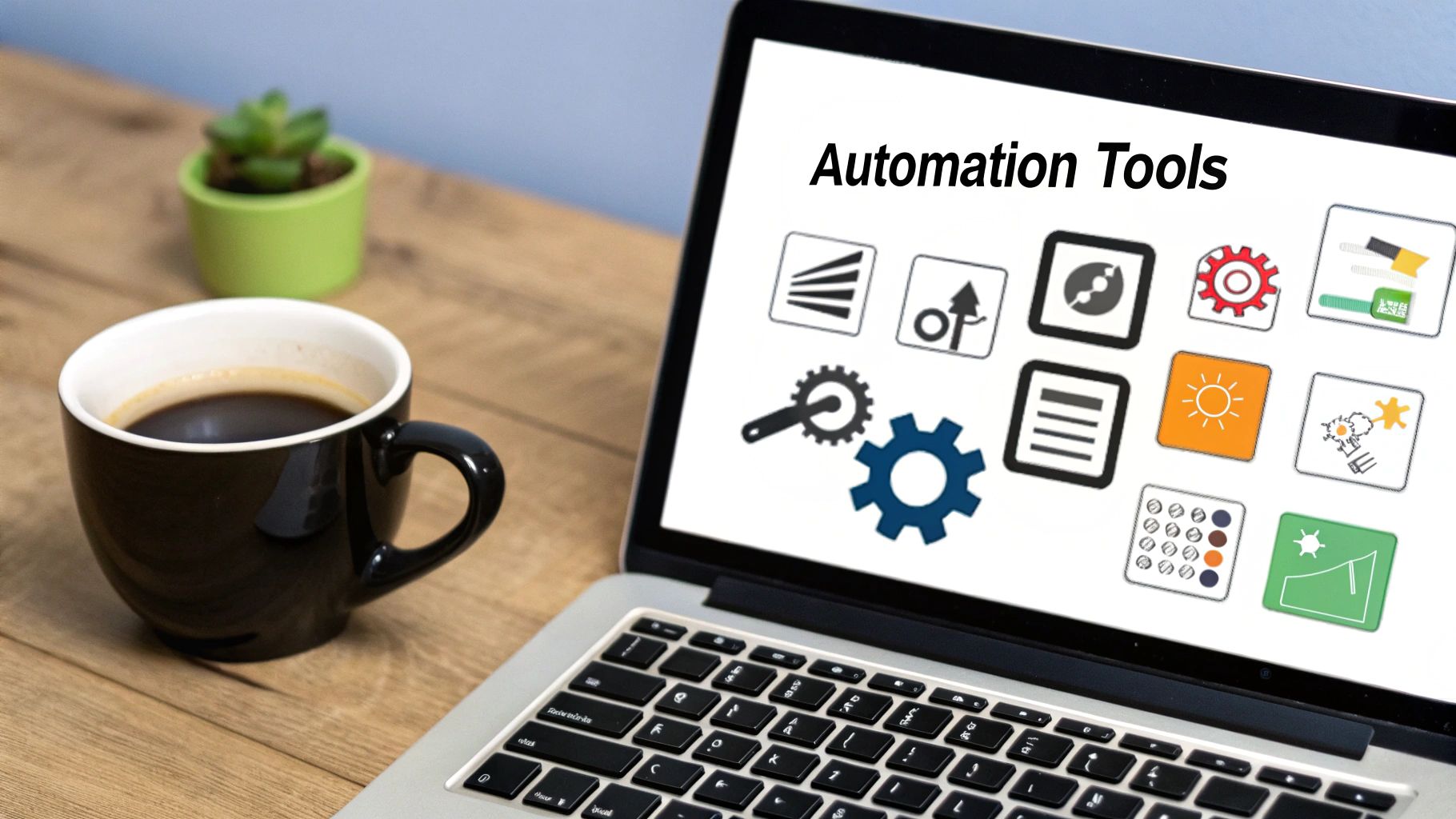Grabbing a generic social media posting schedule template is a solid move for getting organized. But let's be honest—it's just the starting point. The real magic happens when you mold that template to fit your brand, your audience, and your actual business goals. That's when a simple tool becomes your secret weapon for growth.
Why a Standard Template Isn't Enough
Look, starting with a pre-made social media posting schedule template is a great way to avoid the dreaded "what do I post today?" panic. It gives you a basic framework and saves you from the chaos of starting from scratch. But where many people go wrong is stopping there. A one-size-fits-all schedule just can’t grasp the unique rhythm of your audience or the specifics of your industry.
Think about it. The people who follow you on LinkedIn are in a completely different mindset than your audience on TikTok. A generic template might tell you to post three times a week on each, but it's not going to tell you what kind of content will actually stop the scroll or when your specific followers are even online to see it.
A template isn't a rulebook; it's a launchpad. The real value comes from layering your own data, brand personality, and goals on top of it. That’s how you turn a static spreadsheet into a dynamic tool that actually works for you.
Moving Beyond Generic Advice
This is where we shift from just saving time to making a real strategic impact. Customizing your schedule is the difference between simply filling in a calendar and building a content strategy that creates true brand fans and drives measurable results. It’s like the difference between buying a suit off the rack and getting one tailored—both cover you, but only one fits perfectly and makes you look and feel your best.
A schedule that's truly yours helps you do a few key things:
- Develop a genuine brand voice by planning out content themes that actually reflect what you stand for.
- Build real connections by creating posts specifically for the different types of people on each platform.
- Tie every post back to a purpose, whether that's getting more website clicks, finding new leads, or making more sales.
Most of the standard social media advice you hear is just too broad to be useful. Here’s a look at how a strategic approach blows that generic advice out of the water.
Generic Advice vs Strategic Scheduling
| Generic Advice | Strategic Approach |
|---|---|
| Post daily on all platforms | Dig into your analytics to find the ideal posting frequency for each channel. |
| Use popular, trending hashtags | Curate a smart mix of niche, community, and branded hashtags that attract the right people. |
| Share promotions randomly | Plan your promotional content to align with specific campaigns and your audience's buying habits. |
| Repost old content as-is | Refresh and repurpose your best-performing evergreen content with new insights, visuals, or angles. |
Ultimately, a strategic schedule isn't about posting more—it's about posting smarter. It's about making sure every piece of content you share has a purpose and a better chance of hitting the mark.
Finding the Best Times to Post on Each Platform
Let's be honest: a perfectly organized social media posting schedule template is just a pretty spreadsheet if you're posting when your audience is asleep. You've probably seen dozens of guides touting the "best times to post," but those are just a starting point. The real magic happens when you figure out the unique rhythm of your followers on each platform.
It all comes down to user intent. Think about it. An executive scrolling through LinkedIn at 11 a.m. on a Tuesday is in work mode, actively looking for industry news or professional insights. That same person on TikTok at 9 p.m. is winding down and wants to be entertained, not sold to. Your schedule has to respect these completely different mindsets.
This infographic is a great visual for your team to keep handy. It’s a quick reminder of how a well-timed strategy can make your entire content process more efficient.

As you can see, aligning your posts with peak activity isn't just a small tweak—it's the foundation for saving time and getting better results.
Pinpointing Your Prime Time Windows
Stop guessing and start digging into your own data. Every major social platform has built-in analytics that show you exactly when your followers are most active. Just head over to the "Insights" or "Audience" section of your business profile.
You’re looking for those heat maps or bar charts that break down activity by both day and hour. You might find that while conventional wisdom screams "weekday mornings," your audience is full of night owls who are most lively on a Thursday evening. That's the kind of discovery that turns a generic template into a powerhouse for engagement.
If you want to go even deeper on this, we've put together a comprehensive guide on the best times to post on social media in 2025.
The goal isn't just to find when the most people are online, but when the right people are online and in the mood to engage with your type of content. That’s the sweet spot.
Broad industry studies back this up. They show clear, platform-specific patterns. For instance, Instagram often sees a spike on Fridays between 7 a.m. and 8 a.m., while LinkedIn's sweet spot is a tighter 10 a.m. to 12 p.m. on weekdays. TikTok is a different beast entirely, with strong performance on weekday afternoons and even Sunday evenings.
Use these general timings as your starting hypothesis. Then, use your own analytics to test and refine. This is how you build a schedule based on solid evidence, not just a shot in the dark.
Alright, let's tackle the "how often to post" question. Once you've figured out the best times to post, the next big piece of the puzzle is frequency. This is where a lot of people get tripped up.
It's a real balancing act. If you don't post enough, you'll get lost in the noise and your audience will forget you exist. But if you post too much, you risk becoming that annoying brand that just clogs up their feed, begging for an unfollow.
The goal isn't just to hit some arbitrary number. It's about finding a rhythm that feels right for your audience and, just as importantly, is something your team can actually keep up with without burning out or letting quality slide.
The perfect posting frequency lives at the intersection of two things: what your audience actually wants to see from you and what your team can realistically create. Nail that, and you're set up for the long haul.
Let Your Goals Dictate Your Posting Rate
So, what are you actually trying to achieve? Are you playing the long game of building brand awareness, or are you hunting for leads right now? Your answer directly shapes how often you should be posting.
If your main goal is just to get your name out there and stay visible, a higher, more consistent posting frequency usually works best. Think of it as leaving breadcrumbs all over the internet. On the other hand, if you're focused on generating leads, you might find that fewer, more potent posts—the kind that really make someone stop and think—are far more effective.
For instance, a fun e-commerce brand selling directly to consumers might post new products and user photos on Instagram every single day. Their goal is constant visibility. A B2B software company on LinkedIn, however, might only post 3 times a week, but each post is a deep-dive article or a detailed case study designed to attract serious, qualified prospects.

Different Platforms, Different Rhythms
Every social media platform has its own unwritten rules and user expectations. You can find general guidelines everywhere, but what people say you should do and what businesses actually do can be two very different things.
Common advice might suggest posting to Instagram 3-5 times a week or hitting Facebook and LinkedIn 1-2 times daily. Yet, some interesting data I've seen shows that, on average, businesses are really posting around 9.3 times a week on Instagram and a whopping 14.2 times on Facebook. If you're curious, you can explore the data on these social media posting gaps yourself.
This discrepancy is exactly why a one-size-fits-all schedule just doesn't work. Use those industry benchmarks as your starting point, a place to test from. Then, dive into your own analytics. Your engagement numbers—the likes, comments, shares, and clicks—will always tell you the real story of what's working for your audience.
Building Your Evergreen Content System
Why let your best content die after one post? It’s a huge waste of effort. The smartest move you can make is to build a system that keeps your most valuable, timeless content in constant rotation. This is exactly where your social media posting schedule template becomes a powerhouse.
First, let's talk about what "evergreen" really means. It's the content that stays useful and relevant long after you first hit "publish." We’re talking about your cornerstone pieces: in-depth "how-to" guides, revealing case studies, answers to those questions everyone in your industry asks, or glowing testimonials. This stuff doesn't go stale, and it can keep delivering value for months, if not years.
So, where do you find these gems? Start by diving into your analytics. Pinpoint the posts that have historically brought in the most engagement, clicks, or leads. These are your proven winners, the content that your audience has already voted for with their attention.
Strategically Recycling Your Best Work
Once you have your list of evergreen champions, it’s time to build a recycling plan right into your schedule. This isn't about being lazy; it's about being strategic and ensuring you always have high-quality material to fill any gaps in your calendar.
For instance, you could create a dedicated content bucket in your template called "Evergreen Fridays" and plug in one of your top-performing posts to go out at the end of each week. Simple as that.
The point isn't just to spam your feed with repeats. It's about re-introducing genuinely helpful resources to new followers and anyone who simply missed it the first time around. This little habit ensures you squeeze every last drop of value from your best work.
To keep it from feeling stale, give it a quick refresh before it goes live again. Maybe you design a new graphic for it, write a punchier caption, or update a key statistic within the post. It’s a small effort for a big return. If you want a more detailed system for this, our guide on how to create your social media content calendar for better engagement breaks it down perfectly.
Here's another great idea: as you curate your evergreen content, gather your absolute best resources onto a dedicated page. You can use something like a custom Notion Link-in-Bio template to make it look sharp. This approach not only keeps your feed active but also consistently drives traffic without forcing you into the content creation hamster wheel.
Putting Your Schedule on Autopilot

Alright, you've built out your content plan in the template. Now for the fun part: making it work for you automatically. This is where we shift from planning on a spreadsheet to actually getting your content out there without having to manually hit "post" every single time.
This is where social media scheduling tools come into play. Think of platforms like Buffer or Hootsuite. They let you take all that great content you've organized in your template and load it up for the weeks and months ahead. The goal here isn't just to be lazy; it's about being strategic so you can schedule social media posts that drive real results.
Let Smart Tools Handle the Timing
The best part about modern schedulers? Many of them have smart features that figure out the perfect time to post for your audience. No more guessing. These tools analyze your past engagement and tell you exactly when your followers are most likely to be scrolling.
While general wisdom says the best time to post is between 10 a.m. and 1 p.m. on weekdays, that's just a starting point. Your audience might be different. For example, Facebook and Instagram often get a lot of attention in the morning, but TikTok engagement can spike later in the afternoon. A good scheduling tool will pinpoint these unique windows for you, which can make a huge difference in your reach. If you want to see the broader data, you can read the full research about platform-specific timing.
A quick pro-tip: Don't pack your schedule to 100%. I always recommend leaving a few empty slots each week. This gives you the breathing room to jump on trending topics or share something spontaneous. It’s what keeps your feed feeling real and not like a robot is running the show.
Ultimately, you're building a system that delivers consistency while still allowing for flexibility. This frees you up from the daily grind of posting, so you can focus on what really grows your brand: talking to your community.
Answering Your Toughest Scheduling Questions
Even with a killer template, things don't always go according to plan. What happens when you miss a post? Or when your engagement suddenly nosedives? Trust me, these are common hurdles, and I’ve seen them all. Let's walk through some of the most frequent questions so you can navigate these challenges with confidence.
A big one I always get asked is what to do when a major news story or a viral trend takes over everyone's feed. Do you stick to your perfectly planned content, or do you jump into the real-time conversation? My advice? Always build some flexibility into your schedule for this exact reason.
If the trend is genuinely a good fit for your brand and something your audience would care about, it’s almost always worth pausing your regular content. A timely, relevant post shows you're paying attention. Authenticity will win out over a rigid schedule every single time.
What If My Engagement Numbers Suddenly Drop?
It happens to the best of us. One week you’re flying high, and the next, your likes and comments take a dip. The first thing to do is take a breath—don't panic. Instead, put on your detective hat and dig into your analytics to look for clues.
- Did you recently switch up your posting times or how often you post?
- Have you been experimenting with a different type of content lately? Maybe more videos or fewer carousels?
- Is one specific platform struggling while the others are doing fine?
More often than not, a small tweak is all it takes to get back on track. For instance, you might discover your audience has had enough promotional content for a while and is hungry for more behind-the-scenes glimpses into your brand.
Don't ever look at a drop in engagement as a failure. It's actually incredibly valuable feedback from your audience. They're telling you what isn't working, which is just as crucial as knowing what is. This is your cue to pivot and make your strategy even stronger.
Think of your social media posting schedule template as a living, breathing document, not something set in stone. A dip in performance is simply a signal that it's time to open it up and make a few adjustments based on what the data is telling you.
Ready to stop guessing and start automating? EvergreenFeed takes the manual work out of your social media schedule. Fill your content buckets once and let our system post your best evergreen content for you, ensuring your profiles are always active and engaging. Start for free at EvergreenFeed.




